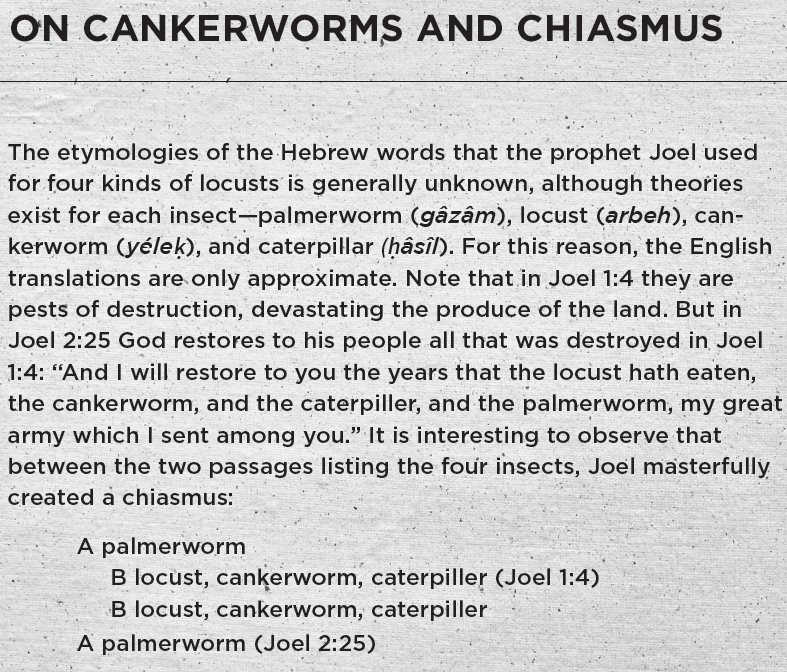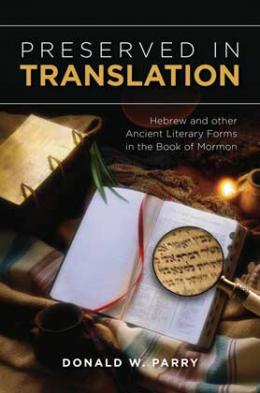Climactic Expressions
Donald W. Perry, “Climactic Expressions,” in Preserved in Translation: Hebrew and Other Ancient Literary Forms in the Book of Mormon (Provo, UT: Religious Studies Center, Brigham Young University; Salt Lake City: Deseret Book), 7‒12.
"when all the saints shall dwell with God" (Moroni 8:26)
In 1898 the biblical scholar E. W. Bullinger identified a significant figure of speech in the Bible that he labeled climax (Greek for ladder).[1] A climactic form contains words or expressions that are duplicated as the writer moves from one phrase or clause to the next. This duplication creates a progression of thought from one sentence to the next, adding power to the discourse through repetition while connecting the lines into a greater whole. Then, at least in some cases, there is an important crowning point, or climax, at the end. Bullinger described climax in the Bible as “a beautiful figure, very expressive; and at once attracts our attention to the importance of a passage.”[2]
Bullinger provides the following biblical example of climax from Joel 1:3–4. To make the form easily recognizable, I have restructured the verse and underlined the duplicated words:
Tell ye
your children of it, and let
your children tell
their children, and
their children another generation. That which the palmerworm hath left hath the
locust eaten; and that which the
locust hath left hath the
cankerworm eaten; and that which the
cankerworm hath left hath the
caterpiller eaten.

Note how the repetition and progression of your children, their children, locust, and cankerworm create a continuation of thought from one segment to the next. In the first sequence, four generations of one family are spoken of—ye, your children, their children, and another generation. This structure indicates an ascension of thought from the first generation to the last. The four generations parallel the four varieties of pests in the second sequence: palmerworm, locust, cankerworm, and caterpillar.
The Book of Mormon exhibits multiple examples of climactic forms.[3] We will briefly look at three.
And the first fruits of repentance is
baptism; and
baptism cometh by faith unto
the fulfilling the commandments; and
the fulfilling the commandments bringeth
remission of sins; and the
remission of sins bringeth
meekness, and lowliness of heart; and because of
meekness and lowliness of heart cometh the visitation of the
Holy Ghost, which
Comforter filleth with hope and perfect
love, which
love endureth by diligence unto prayer,
until the end shall come, when all the saints shall dwell with God. (Moroni 8:25–26)
This extended climactic form has five duplicated words or phrases: baptism, the fulfilling the commandments, remission of sins, meekness and lowliness of heart, and love. Additionally, Holy Ghost parallels Comforter. These words reflect an ascension of experience from repentance to baptism to the remission of sins to the Holy Ghost to love, or the gift of charity. The passage ends with an important climax that suggests the outcome of pursuing the prescribed course of action: “when all the saints shall dwell with God.”
Another powerful climactic passage, in Mormon 9:12–13, begins with the Fall of Adam and concludes with humankind’s being “brought back into the presence of the Lord” because of Jesus Christ.
Behold, he created
Adam, and by
Adam came
the fall of man. And because of
the fall of man came
Jesus Christ, even the Father and the Son; and because of
Jesus Christ came the
redemption of man. And because of the
redemption of man, which came by
Jesus Christ, they are brought back into the presence of the Lord.
The key terms in this passage stand as opposites to each other: fallen Adam, corresponding to fall, is a functional opposite of Jesus Christ, corresponding to redemption; and fall of man similarly contrasts with redemption of man. This passage also sets forth an important sequence—God created Adam, Adam brought about the Fall, Christ came to redeem us because of the Fall, and He, as the Redeemer, indeed brought about our redemption. The climax at the conclusion of the passage states that because of Jesus Christ, Adam and all humankind are “brought back into the presence of the Lord.”
A passage Alma 42:22–23 is another impressive climactic form in the Book of Mormon:
But there is a law given, and a punishment affixed, and a
repentance granted; which
repentance, mercy claimeth; otherwise,
justice claimeth the creature and executeth the
law, and the
law inflicteth the punishment; if not so, the works of
justice would be destroyed, and
God would cease to be God. But
God ceaseth not to be God, and
mercy claimeth the penitent, and
mercy cometh because of the
atonement; and the
atonement bringeth to pass the
resurrection of the dead; and the
resurrection of the dead bringeth back men into the
presence of God; and thus they are restored into his
presence.
In addition to featuring a climactic structure, this passage has two internal chiasms: justice, law, law, justice and repentance, mercy claimeth, and mercy claimeth the penitent. The consciously crafted duplication gives special emphasis to the truths being taught.
This passage also emphasizes the principle of causation: justice executes the law; the law inflicts the punishment; God brings about the Atonement; the Atonement brings about mercy; the Atonement also brings about the Resurrection. Then, in the climactic ending of this passage, Alma testifies that because of the Atonement and Resurrection, we will be able to return to God’s presence.
Notes
[1] Bullinger, Figures of Speech Used in the Bible, 256–59.
[2] Bullinger, Figures of Speech Used in the Bible, 256.
[3] See Parry, “Climactic Forms in the Book of Mormon” and Poetic Parallelisms in the Book of Mormon, xxvi–xxviii. Additional examples include 1 Nephi 15:13–20, 33–35; 2 Nephi 1:13; Mosiah 2:17–19; Alma 42:17–20; Helaman 5:6–8; Mormon 9:12–13; and Ether 3:15–16.
